G. Sun
MAD: Meta Adversarial Defense Benchmark
Sep 18, 2023Abstract:Adversarial training (AT) is a prominent technique employed by deep learning models to defend against adversarial attacks, and to some extent, enhance model robustness. However, there are three main drawbacks of the existing AT-based defense methods: expensive computational cost, low generalization ability, and the dilemma between the original model and the defense model. To this end, we propose a novel benchmark called meta adversarial defense (MAD). The MAD benchmark consists of two MAD datasets, along with a MAD evaluation protocol. The two large-scale MAD datasets were generated through experiments using 30 kinds of attacks on MNIST and CIFAR-10 datasets. In addition, we introduce a meta-learning based adversarial training (Meta-AT) algorithm as the baseline, which features high robustness to unseen adversarial attacks through few-shot learning. Experimental results demonstrate the effectiveness of our Meta-AT algorithm compared to the state-of-the-art methods. Furthermore, the model after Meta-AT maintains a relatively high clean-samples classification accuracy (CCA). It is worth noting that Meta-AT addresses all three aforementioned limitations, leading to substantial improvements. This benchmark ultimately achieved breakthroughs in investigating the transferability of adversarial defense methods to new attacks and the ability to learn from a limited number of adversarial examples. Our codes and attacked datasets address will be available at https://github.com/PXX1110/Meta_AT.
Transformer Language Models with LSTM-based Cross-utterance Information Representation
Feb 12, 2021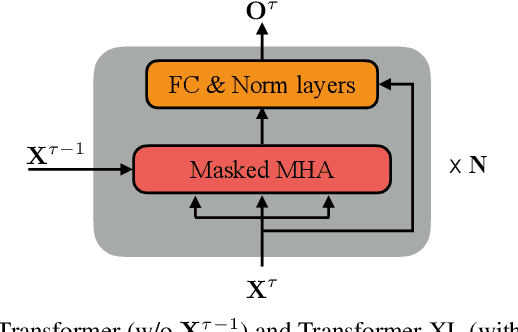
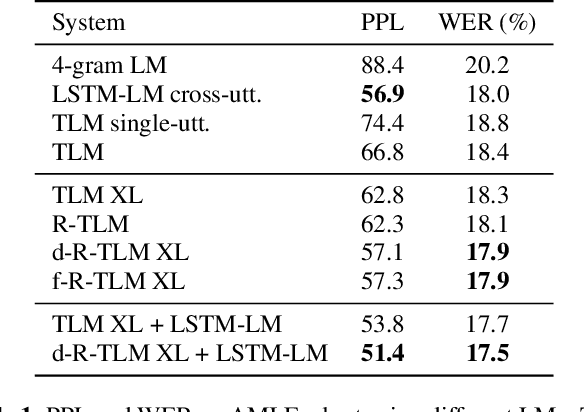
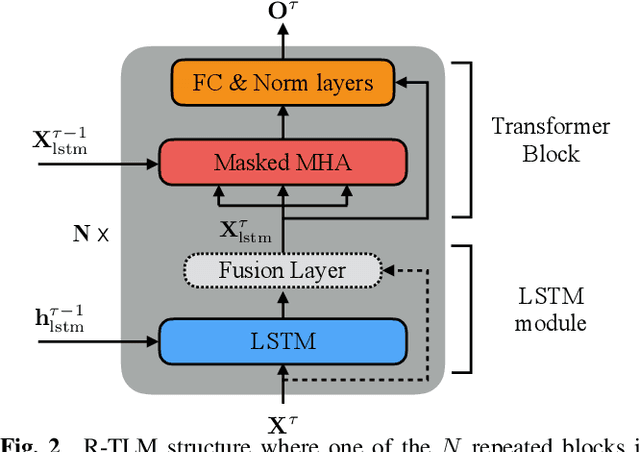
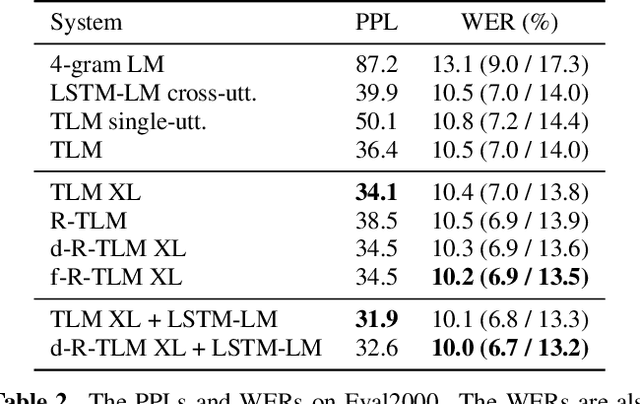
Abstract:The effective incorporation of cross-utterance information has the potential to improve language models (LMs) for automatic speech recognition (ASR). To extract more powerful and robust cross-utterance representations for the Transformer LM (TLM), this paper proposes the R-TLM which uses hidden states in a long short-term memory (LSTM) LM. To encode the cross-utterance information, the R-TLM incorporates an LSTM module together with a segment-wise recurrence in some of the Transformer blocks. In addition to the LSTM module output, a shortcut connection using a fusion layer that bypasses the LSTM module is also investigated. The proposed system was evaluated on the AMI meeting corpus, the Eval2000 and the RT03 telephone conversation evaluation sets. The best R-TLM achieved 0.9%, 0.6%, and 0.8% absolute WER reductions over the single-utterance TLM baseline, and 0.5%, 0.3%, 0.2% absolute WER reductions over a strong cross-utterance TLM baseline on the AMI evaluation set, Eval2000 and RT03 respectively. Improvements on Eval2000 and RT03 were further supported by significance tests. R-TLMs were found to have better LM scores on words where recognition errors are more likely to occur. The R-TLM WER can be further reduced by interpolation with an LSTM-LM.
Content-Aware Speaker Embeddings for Speaker Diarisation
Feb 12, 2021
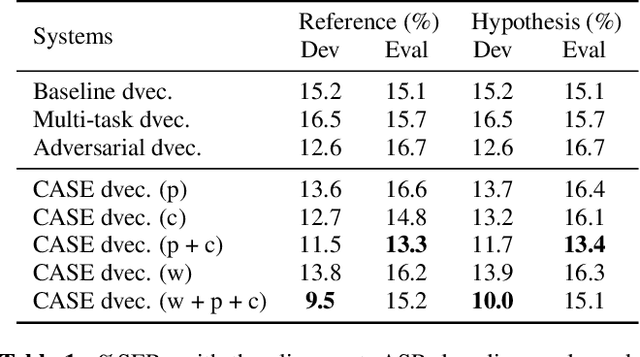
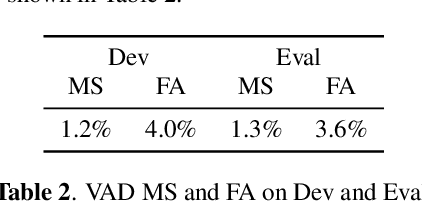

Abstract:Recent speaker diarisation systems often convert variable length speech segments into fixed-length vector representations for speaker clustering, which are known as speaker embeddings. In this paper, the content-aware speaker embeddings (CASE) approach is proposed, which extends the input of the speaker classifier to include not only acoustic features but also their corresponding speech content, via phone, character, and word embeddings. Compared to alternative methods that leverage similar information, such as multitask or adversarial training, CASE factorises automatic speech recognition (ASR) from speaker recognition to focus on modelling speaker characteristics and correlations with the corresponding content units to derive more expressive representations. CASE is evaluated for speaker re-clustering with a realistic speaker diarisation setup using the AMI meeting transcription dataset, where the content information is obtained by performing ASR based on an automatic segmentation. Experimental results showed that CASE achieved a 17.8% relative speaker error rate reduction over conventional methods.
Cross-Utterance Language Models with Acoustic Error Sampling
Aug 19, 2020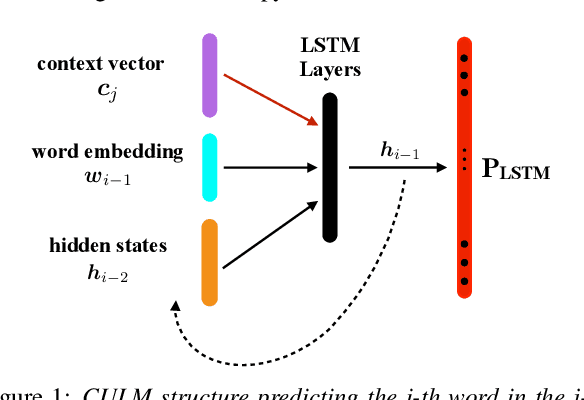

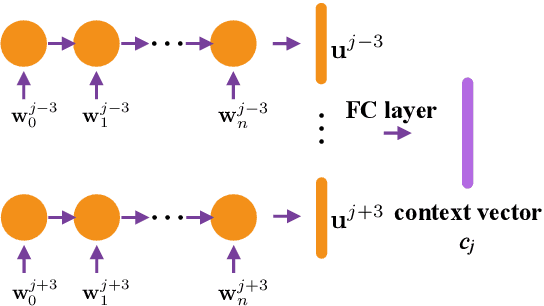

Abstract:The effective exploitation of richer contextual information in language models (LMs) is a long-standing research problem for automatic speech recognition (ASR). A cross-utterance LM (CULM) is proposed in this paper, which augments the input to a standard long short-term memory (LSTM) LM with a context vector derived from past and future utterances using an extraction network. The extraction network uses another LSTM to encode surrounding utterances into vectors which are integrated into a context vector using either a projection of LSTM final hidden states, or a multi-head self-attentive layer. In addition, an acoustic error sampling technique is proposed to reduce the mismatch between training and test-time. This is achieved by considering possible ASR errors into the model training procedure, and can therefore improve the word error rate (WER). Experiments performed on both AMI and Switchboard datasets show that CULMs outperform the LSTM LM baseline WER. In particular, the CULM with a self-attentive layer-based extraction network and acoustic error sampling achieves 0.6% absolute WER reduction on AMI, 0.3% WER reduction on the Switchboard part and 0.9% WER reduction on the Callhome part of Eval2000 test set over the respective baselines.
 Add to Chrome
Add to Chrome Add to Firefox
Add to Firefox Add to Edge
Add to Edge